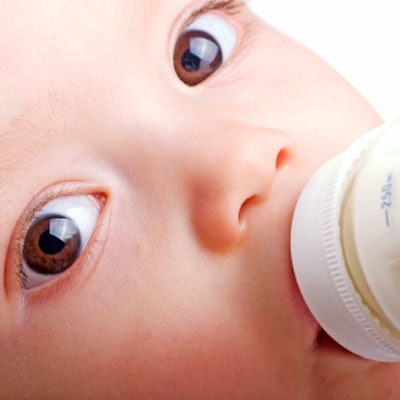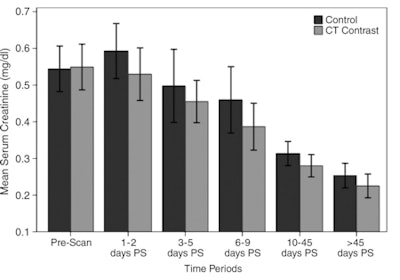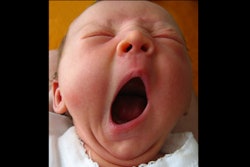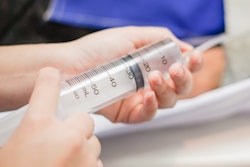
A review of inpatient neonates suggests that babies with normal renal function who receive iodine-based CT or gadolinium-based MRI contrast agents have no greater risk of renal toxicity than those not receiving contrast, according to results published in the August issue of Radiology.
Among a group of 140 infants younger than 30 days old, two key indicators of renal function performance -- serum creatinine levels and glomerular filtration rate (GFR) -- stayed within acceptable ranges soon after contrast administration. In addition, there were no lingering aliments, such as nephrogenic systemic fibrosis (NSF), two years and four years later (Radiology, August 2017, Vol. 284:2, pp. 530-540).
"We feel significantly better with these results to know we are not harming the babies," said lead author Dr. Maria Alejandra Bedoya, a second-year radiology resident at the University of Pennsylvania and the Children's Hospital of Philadelphia (CHOP). "It is important to know that, especially with these patients who have no other option but to receive contrast."
Delicate neonates
Serum creatinine levels are one method of determining whether a neonate -- a baby younger than 30 days old -- has adequate renal function to rid the body of contrast. Unlike with adults, there is no established threshold above which contrast media would be prohibited in these young patients.
 Dr. Maria Alejandra Bedoya from Children's Hospital of Philadelphia.
Dr. Maria Alejandra Bedoya from Children's Hospital of Philadelphia.High creatinine levels indicate that a person's kidneys may not be able to excrete contrast from the body. Based on the creatinine level, as well as a patient's weight, body mass index, and other factors, clinicians can calculate the glomerular filtration rate, or the person's ability to eliminate the contrast. With neonates, because they are so young, their mothers' serum creatinine levels can influence the babies' readings. In fact, neonates' creatinine levels can range from 0.1 to 0.94, according to the researchers.
"If you would analyze that, you might say that this baby is in kidney failure, but the truth is that the kidneys are immature, and with time, the creatinine levels will begin to go down because the kidneys are beginning to function and clear out the creatinine," Bedoya said.
Contrast parameters
To help determine the appropriate use of contrast in neonates, CHOP established a multidisciplinary group of radiologists, neonatologists, and pediatric nephrologists to devise a set of contrast parameters. When the team met, however, it found very little previous research on the topic. And while the U.S. Food and Drug Administration (FDA) has cleared the use of certain contrast agents for imaging young patients, the agency has not discussed contrast use in neonates.
"We realized that with the guidelines we were going to make, we did not have much literature support," Bedoya said. "For that reason, we analyzed [CHOP] cases to see if we may be harming the neonates when we were administering the contrast agents, because they were being used [off] label."
Clinicians opt for contrast-enhanced CT and MRI scans only as a last option for neonates in more serious cases -- such as for those who need cardiac imaging to determine a suspected abnormality that could not be distinguished with a noncontrast-enhanced scan.
"We would start giving an MRI scan without contrast and we could not see anything; then we will give contrast for surgical planning or to diagnose what kind of cardiac abnormality they may have," Bedoya explained to AuntMinnie.com. "Also, in cases of tumors and other suspicious neonatal masses, we usually need to see the enhancement of the lesions to determine if it is malignant or benign, or if resection is necessary."
Renal readings
For this retrospective study, a total of 280 subjects from January 2011 to April 2013 met the inclusion criteria. The researchers divided 140 neonates into a contrast-enhanced CT group (59 subjects) and a contrast-enhanced MRI group (81 subjects). In addition, 140 neonates who underwent unenhanced CT or MRI scans served as separate CT and MRI controls. The control neonates were matched for gender, preterm or term status, and postnatal age for follow-up with the babies given contrast.
Depending on the scan, neonates in the contrast-enhanced CT group received either iodixanol (Visipaque, GE Healthcare) or iohexol (Omnipaque, GE). In the contrast-enhanced MRI group, subjects received gadopentetate dimeglumine (Magnevist, Bayer HealthCare Pharmaceuticals).
Serum creatinine levels were obtained at six time points, beginning with baseline readings within 72 hours before imaging and at least one reading after imaging. The readings then extended to more than 45 days. Serum creatinine levels and GFRs for each time period were compared. The researchers also performed follow-ups on the subjects at two years and four years to see if they had signs of NSF.
Bedoya and colleagues found that creatinine levels decreased and GFRs increased in both groups from before to after imaging (CT group, p ≤ 0.01; MRI group, p ≤ 0.01). In addition, the neonates who received contrast and those who had unenhanced scans showed similar serum creatinine levels at all time points.
 Serum creatinine levels in contrast-enhanced and unenhanced CT (above) and MRI (below) groups for each time period. Images courtesy of Radiology.
Serum creatinine levels in contrast-enhanced and unenhanced CT (above) and MRI (below) groups for each time period. Images courtesy of Radiology.The proportion of subjects with serum creatinine levels higher than the reference range (> 0.4 mg/dL) did not differ with the use of contrast (CT, p > 0.12; MRI, p > 0.13), compared with the neonates who had unenhanced scans. Similar findings were observed for GFR, the authors wrote.
After controlling for age, the researchers also found no group differences in serum creatinine levels or estimated GFR at any time period (p > 0.07), except in the MRI group at 10-45 days. That is when neonates in the unenhanced MRI control group had higher serum creatinine levels (mean, 0.34 mg/dL) than neonates in the contrast-enhanced MRI group (mean, 0.27 mg/dL; p = 0.04). However, both values were within the reference range.
No NSF evidence
Another key finding is the absence of NSF in the subjects at two- and four-year follow-up, although the authors noted that NSF is "rare in children, and, to our knowledge, no cases have been reported in neonates or infants."
"Even though we are very confident that we are not harming the babies, we always have to keep our eyes open, at least for NSF," Bedoya said. "Even though we followed them for two to four years, some cases [of NSF] can develop later."
The researchers cited several limitations of the study, including the fact that all subjects were inpatients. The setting would suggest that the neonates were under close monitoring, which could have prevented renal side effects from the contrast.
"It is important to know that ... most of these cases are inpatients, so they are more under control than the normal population," Bedoya said. "If caregivers see the creatinine levels begin to increase, they can give the neonates more fluid."
In addition, the hospital's protocol stipulates that contrast material not be given to infants with "clear evidence of renal compromise, and thus, our findings are limited to neonates without renal failure," the authors wrote.




















